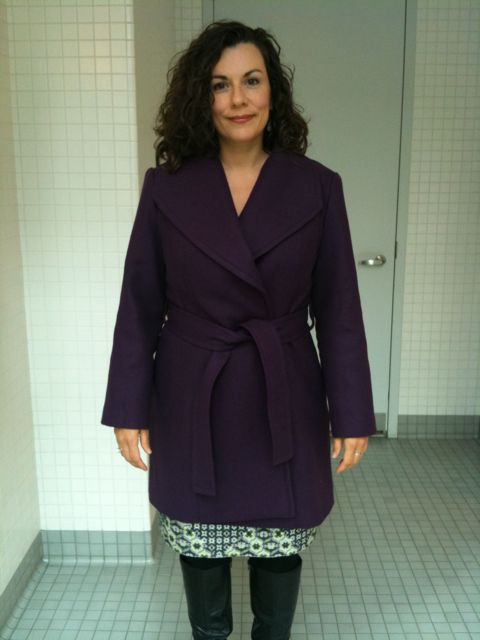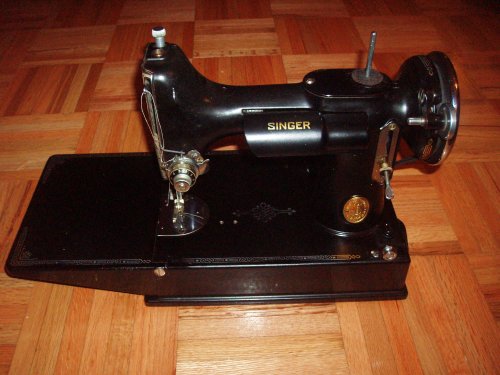Here’s my pattern review for Simplicity 2311, my beloved purple coat pattern. I’m officially in love. 🙂
Pattern Description: Misses’ Coat in two lengths with collar, sleeve and belt variations. I made Coat B in the shorter length with the tie belt and wide collar. I did not include any buttons as my fabric was grabby and the belt was sufficient to keep the coat closed.
Pattern Sizing: 14-22. I made the sz 14 and found it very true to size with little fitting adjustments needed.
Did it look like the photo/drawing on the pattern envelope once you were done sewing with it? Yes! Yes! Yes! (aside from the different color fabric)
Were the instructions easy to follow? The instructions were easy to follow if you read carefully. I found myself skipping on ahead thinking I understood everything perfectly. It really pays to read and follow along one or two sentences at a time before moving on to the next step.
What did you particularly like or dislike about the pattern? I LOVED the pattern; it is drafted so well. The collar did not need any pad stitching to retain its shape. My teacher said that most RTW collars don’t have any pad stitching, especially when using a fusible interfacing, and I took the excuse and ran with it; the collar came out great.
The princess seams and CB seam allowed for great fitting opportunities. I love the multiple opportunities for top stitching, which takes this coat from plain jane to a gorgeous model in heartbeat. My Emerald 183 has a special topstitching stitch that made my topstitching look so professional. I recommend loading up on matching thread if you plan to topstitch most of the seams. I used 3 and a half spools of Gutterman thread for this project. Top stitching accuracy is easy, if you take it slow.
FYI: I did not find there to be excess ease in the sleeve head. Yes, you had to gather, but with a wool fabric, I would expect that. In fact, I found the amount of ease needed to be gathered quite minimal. I did not have any problems with puckering nor did I end up with a poofy sleeve. Love that!
The only dislikes I have, which are minor, are that the hem with the lining attached needs to be tacked to the shell. That instruction was not included in the pattern sheets. I think its necessary or else the hem will sag and show the lining. I will tack my hem down tonight.
Also, I think some kind of hand stitching in the ditch is needed to join the upper collar/lining/under collar together at the shoulder/neck area so that they act as one piece instead of two pieces that can pull away from each other as you take the coat on and off. But these are minor points and would probably be obvious to advanced sewists.
Any difficulties encountered? The most difficult part of this pattern is when you attach the shoulder and collar to the back yoke. The shoulder and collar form a U when sewn together and sewing that U shape to the squarish yoke is a bit tricky. You have to pivot at just the right spot making sure not to catch the shoulder in the seam you’re creating. And then after the pivot, you have to move the collar out of the way to continue. Just make sure you sew this part slowly and carefully and you will be fine. I even needed to do one pivot over again, and it was actually easier to do the second time, because the stitching from the first pass allowed me to hold the pieces together better for more accurate sewing.
Fabric Used: I used an imperial purple wool purchased from FabricMart in Sept 2009 and a silk charmeuse in a coordinating purple color from Metro Textiles purchased in August 2010.
Both fabrics were a dream to sew. The wool pressed beautiful.
Pattern alterations or any design changes you made: The only fitting change I made to the pattern was to sculpt the CB seam to take some of the squarishness out of the fit and give it a more fitted and tapered look from the shoulder blade to waist area (in total I took about .75 inches out tapering to the yoke and waist). I thought I might need to fiddle with the princess seams in front, but left them as is so I could wear suit jackets underneath if need be.
I did add some interior structure changes to the pattern such as a interfacing all the pattern pieces, and adding a back stay and sleeve heads. The pattern already called for shoulder pads which I included, but I decided to make my own since I didn’t like the store bought ones that I had bought for this project which were made out of foam. I just looked at my RTW winter coat to see how its shoulder pads were constructed and did the same.
Would you sew it again? Would you recommend it to others? I honestly can say that I would sew this again. I tend to do only one complicated project a year, so I won’t probably make this again anytime soon, but I love this pattern. When I make it again, I might place the carriers lower on the coat as I am long waisted. As they are indicated on the pattern, they fall about an inch or two below an empire waist. I would like them about an inch lower. So be sure to check placement for yourself before blindly following the pattern’s placement.
I definitely would recommend this pattern. Maybe not to a beginner as it is a long and involved project (although a beginner could definitely make this pattern; I just think it’s a complicated process to make a coat with many opportunities for frustration), but an intermediate or advanced beginner would definitely enjoy making this pattern. I think an advanced sewist would enjoy the excellent drafting and fit of this coat and could add more structure and couture details to make it their own.
Conclusion: Great pattern!!!! I love my coat and am so proud of the work I put into it and all the interior structure details I included. I received so many compliments today on my coat.














































